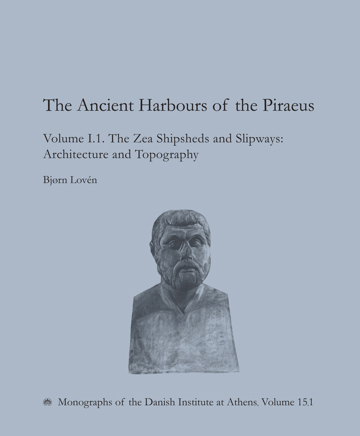
The Ancient Harbours of the Piraeus
The Zea Shipsheds and Slipways
En del af serien Monographs of the Danish Institute at Athens (15.1+15.2) , og fagområderne Antikforskning, Arkæologi og Arkæologi (klassisk)
Med bidrag af
B. Klejn-Christensen og
M.M. Nielsen
Mere om bogen
Om bogen
Volume 15.1: Architecture and Topography
Volume 15.2: Finds, Area 1 Shipshed Roof Reconstructions and Feature Catalogue
Athens in the Classical period was preeminent because of her naval power.
The architectural glories of the Acropolis stood in second place to her naval bases according to an unknown Athenian writer:
O Athens, queen of all cities!
How fair your naval base!
How fair your Parthenon! How fair your Piraeus!
- Com. Adespot. 340
The immense historical importance of the navy of Classical Athens is evident in her struggles against Persia ending at the Battle of Salamis, the city's central role in the First Delian League, the decades of Athens' supremacy as an imperial naval power, the victories and vicissitudes of the Peloponnesian War, and the revival and fall of the Athenian navy during the 4th century BC. With Athens navy's importance came that of her harbour city, the Piraeus, where naval bases in Zea, Mounichia and Kantharos Harbours housed hundreds of triremes that served as the primary arm of Athenian power.
This first volume in the peer-reviewed Ancient Harbours of the Piraeus series is the culmination of the first phase of archaeological investigations conducted by the Zea Harbour Project, 2001-2006. The study focuses on Zea Harbour, where two previously unidentified building phases were discovered: the unroofed Phase 1 slipways, most likely belonging to the early 5th century BC, and the Phase 2 shipsheds built later in that century. This is the first solid material evidence of the naval installations dating to the zenith of Athenian military, political and cultural hegemony. In addition, shipsheds (Phase 3) that have been documented previously by W. Dörpfeld and I.C. Dragátsis (1885) are dated to 375-350 BC (terminus post quem) and architecturally redefined as double-unit shipsheds designed to house two ships stored end-to-end. Also among the principle discoveries are the establishment and measurement of the relative changes in sea level since antiquity - a key piece of the puzzle, and one that has led to a broader understanding of the topography of the ancient harbours of the Piraeus.
The naval installations built in Zea Harbour in the 4th century BC were amongst the largest building complexes of antiquity and were essential for maintaining an operational fleet. In the late 330s BC, the shipsheds at Zea extended over an area of more than 55,000 m2; including the shipsheds in Kantharos and Mounichia Harbours, the total area covered by the shipshed complexes in the Piraeus was close to 110,000 m2. Hundreds of colonnades and side-walls carried the massive tiled roofs of these shipsheds, which clearly conveyed Athens' determination to 'monumentalise' and glorify the naval bases that protected the city's fleet of swift triremes at the height of her power.
For purchases outside of Denmark:
If you are located in the USA or Canada, please contact our US distributor, Longleaf Services, at orders@longleafservices.org or +1 919-503-6590.
For purchases in all other countries, you can find the title through our global distributor, The Mare Nostrum Group, here: https://mngbookshop.co.uk
Pressen skrev
Carmelo Di Nicuolo, Bryn Mawr Classical Review
"The objective of this book is to review the topography and the architectural aspects of the Zea shipsheds and slipways. This is only the first step in a challenging editorial project to be published in five volumes, where both the results of ongoing research in Zea and those provided by future exploration scheduled in Mounichia for 2014 will be presented."
"This is only the first of five volumes, which, when complete, will provide a veritable encyclopedia of Piraeus naval arhaeology. Nevertheless, the quantity of data collected and the excellent study of the architecture of the naval installations of Zea, accompanied by top-quality graphic documentation, represent an essential tool for anyone who wants to study the topography and spatial organization of harbour districts in port cities of the ancient world."
Netop udkommet
Forlaget skriver:
25 november 2025
Årets sidste bogtorsdag!
Årets sidste bogtorsdag er nu lige på trapperne! Vær med, når vi, sammen med Det Kgl. Bibliotek, fejrer forfatterne bag vores…
29 oktober 2025
Kom til bogtorsdag d. 13. november!
Vi er nu klar med novembers bogtorsdag!Vær med når Aarhus Universitetsforlag sammen med Det Kgl. Bibliotek fejrer forfatterne…
29 september 2025
Kom til Bogtorsdag den 9. oktober
Vær med når Aarhus Universitetsforlag sammen med Det Kgl. Bibliotek fejrer forfatterne bag vores nyeste udgivelser til Bogto…




